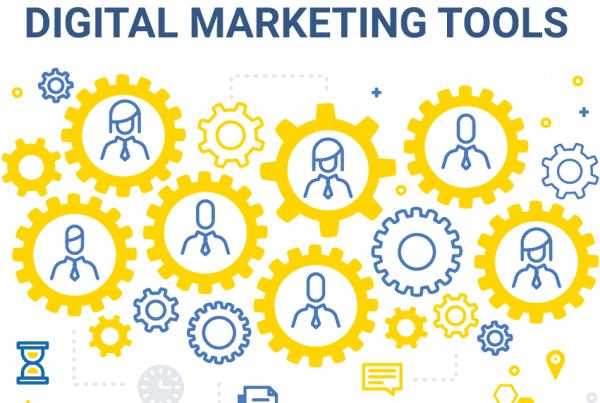Whether or not you realize it, you have been a part of the customer experience—probably on both ends—as a customer and as a marketer. This post will walk you through the ins and outs of the customer experience, help you put some language to the topic, and lay out some ways to improve.
But before beginning the customer experience journey, let’s talk briefly about Apple. According to a study from CNBC’s All-America Economic Survey, 50 percent of all households in the United States are home to at least one Apple product.
That’s crazy. How do they do it? You might suggest it’s their brand that has created countless loyal customers.
And you’d be correct, but how did you become aware of their brand? How did you get familiar with Apple and learn what they’re all about? What hooked you?
The Customer Experience
Customer Experience is the vehicle that carries your brand into the world. And it’s so important that Walkerinfo – following an extensive study in 2017 – predicts that by the year 2020, the customer experience will be a bigger factor in the buying process than product or price. In fact, 81% of marketing leaders already agree that they are increasingly competing on customer experience, more than on product or price.
This means having a higher quality product than your competition will no longer be enough. Even having a cheaper product than your competitors will no longer be enough.
If the customer experience (CX) is that important, let’s dig in.
What is Customer Experience?
Customer Experience is defined as the product of an interaction between an organization and a customer. It’s important to note that customer experience doesn’t refer to the interaction itself, but the product of the interaction.
The product we’re speaking to is the way your customer feels.
Customer experience is all about the customer’s perception of your organization. Keep in mind that we’re not talking about how you feel about the interaction, or what kinds of feelings you think the interaction should evoke, but your customers’.
For instance, you may think your organization is all about A. You think your organization evokes a feeling of A, your tone is A, your voice is A – but your customer feels that it’s more about B… Guess what? Your organization is in fact all about B.
So, if you take the sum of a persons’ feelings across every interaction they have with your organization – and put them all together – that is your customer experience.
Where Does Customer Experience Happen?
Everywhere.

Customer experience takes place throughout many different interactions. We refer to these interactions as touchpoints: any time a customer or potential customer comes in contact with your brand – before, during, or after they make a purchase.
From the first time a customer sees a billboard all the way to the exit survey, there are countless touchpoints throughout the customer journey. Each one of these touchpoints is critical to the overall customer experience.
Some would say these touchpoints are limited to the time period in which a person is actually a customer. But because “pre-sale” touchpoints with a company can often play a role in the customer’s perceptions once becoming a customer, we’ll reference touchpoints that take place even before purchase.
Here are a few categories to help you picture the journey of a customer:
Before Purchase
Long before you actually pick up the phone or send an email, people are having interactions with your organization. These interactions can have an effect on the journey once becoming a customer – and even affect whether or not they become one in the first place. There are plenty of things to consider here: your marketing materials, what customers’ friends say about your organization, and even how your company leadership is perceived by the community. Some other pre-sale touchpoints to consider:
- Advertising
- Marketing Material
- Social Media
- Leadership
- Word of Mouth
- Reviews / Testimonials
- PR
During Purchase
Regardless of what your sales process looks like – whether it’s 5 seconds or 5 months long – it plays a big role in the customer experience. Some sales process touchpoints to consider:
- Initial meeting
- Phone Calls
- Emails
- Purchase / POS / Signed Contract
Post-Purchase
For some, post-sale means the actual use of the product, or the experience of the service. For others, post-sale might refer to some kind of ongoing support or maintenance. It may be as simple as an exit survey. Regardless, the final touchpoint can often have the most lasting impact on a customer. Here are some other examples of post-purchase touchpoints:
- Billing
- Marketing Emails
- Company Updates
- Help Center / Support
- Follow Ups
Let’s continue to look at Apple as an example. Here are some touchpoints you might have with Apple:
- Viewing Commercials on Television
- Viewing Ads on the Internet
- Talking with Friends who have Apple products
- Watching an interview with their CEO
- Walking into an Apple store
- Purchasing a Product
- Opening a Product
- Calling the Support Team
…and there are probably hundreds more. Touchpoints happen everywhere.
What are the Goals of the Customer Experience?
At each of the above touchpoints, and at the end of the customer journey, what should the customer experience look like? What is a successful CX? There are three goals that should define any customer experience:
-
- A Positive Experience
This is a pretty easy one – the customer experience should be a positive one – or a delightful one. 86% of consumers say they are likely to repurchase from a company who provides a positive customer experience. They should walk away from interactions with your organization feeling delighted. - A Consistent Experience
Consistency is key. 75% of consumers expect a consistent experience wherever they engage –social networks, in-person, online, by phone, etc. The customer’s overall takeaways should be consistent across the board. - An Accurate Experience
Not only should experiences be consistent, but they should be inline with business and marketing goals. The way a customer feels should be the way you want them to feel based on your brand goals.
- A Positive Experience
Is Customer Experience the Same as User Experience?
User experience (UX) typically refers to how a person feels when interacting with a system or a product. While customer experience references the entire customer journey, user experience refers to the user’s journey through a single product, system, or environment. More specifically, UX often refers to digital products and digital experiences. The user experience prompts questions such as:
- Who is your audience?
- What’s the most important task for them to accomplish?
- How can we make that task as easy as possible to accomplish?
- Does the user feel success once the task is accomplished?
While not synonymous, UX lives under the umbrella of the CX, and it is essential to customer success. CX and UX follow many of the same principles, but user experience has a more focused application.
Is Customer Experience Relevant for Small Businesses?
It’s tempting as a small business to think, “I only have a few competitors in my local area. I don’t need to look at the customer experience, small business marketing is hard enough already. I’ll just continue to rely on word of mouth and my brand.”
Let us reiterate a tidbit we shared at the beginning of this post: customer experience is the vehicle that delivers your brand to your audience. The CX is what creates that word of mouth content.
Even in local markets, you will soon no longer be able to beat your competition with a better product or a cheaper price point. You need to deliver a top notch experience. Your customers have to walk away thinking, “Man, that organization is AWESOME.” So while you’re relying on your brand and your 50 years in business, someone is coming along ready to beat you out with a great CX.
And finally, CX is relevant for small organizations because you will grow. Creating a great customer experience only gets harder as your company gets bigger and as you add customer touchpoints. The time is now.
Now that we’ve got some language to work with, and we’ve addressed some misconceptions, let’s get practical.
How to Improve Your Customer Experience
In order to improve, you first have to know how you’re performing at present. This begins with an audit:
A 3 Step CX Audit
- Know Your Brand
It’s tough to start considering how to deliver your brand when you don’t know what it is. We’ve hinted at branding throughout this post, but we haven’t really defined it. Put very simply, brand is what your organization is all about. It’s your promise to the customer. Your brand is the feeling your customer gets after interacting with you – which is why it’s essential to start here when considering the CX. What feeling do you want people to have when your organization pops in their heads? - Know Your Touchpoints
You’ve got to be familiar with all of your touchpoints, which refer to ANY interaction a consumer has with your brand – before, during, or after their time as an actual customer. We recommend getting the team together, grabbing a whiteboard, and jotting down each and every possible way you can imagine someone having an interaction with your organization. Think through everything. - Audit Each Touchpoint
At each and every one of the touchpoints you identify, you’ve got to ask the question: “How does this make my customer feel?”
How does your customer feel during and following that touchpoint? Is it delightful? Is it consistent with their feelings at other touchpoints? And is it accurate with your brand?
This can be a time consuming task, but one that yields big time benefits.

7 Tips to Build a Culture that Values CX
- Hire the right people
It’s essential to get the right people on your team. Vision and brand trickle down a company’s organizational chart, rarely up. It’s critical that leaders trust those to whom their vision is trickling down. They will be the ones interacting with customers at various touchpoints most often. - Get everyone on board
Once you’ve got the right people in the right seats, it’s important to make sure they’re on board. They must first be on board with your brand, and secondly with how that brand is communicated across each and every touch point. Having people on different pages is the best way to create an inconsistent experience. - Get to know your customers
As you analyze your touchpoints, you could guess at how customers feel at each of them. Or you could simply ask. Knowing your customers, what they love, what they hate, and how they feel about your organization will help you make the best decisions as you continuously seek to improve your customer experience. - Emphasize Listening
How do you get to know customers? It’s not by talking at them—but by asking questions and having conversations. Does the customer always know what’s best for them? Not often, but you certainly won’t know if your ears are closed. - Make Feedback Easy
Not every customer will be so eager to let you know how they feel. Many will, but for some customers, they need a little nudge. Make feedback easy for them. It is your responsibility to GET feedback, not your customers’ to GIVE it. Make surveys a regular occurrence at the end of all your processes, and get in the habit of asking “how did we do?” - Continuously Analyze Your Touchpoints
The customer experience is not a “set it and leave it” process. Our culture changes almost daily, and because of that, how an interaction makes someone feel will also change. What was a delightful customer experience in 2008 may no longer be so positive. What made for a great mobile experience even in 2016 will no longer suffice.
Customer experience is a big topic. There are numerous aspects to consider and the applications range from quick tasks to completely revamping your entire organization. Here are some additional resources to help you on your journey:
Customer Experience Resources
Start the Conversation
Interested in learning more about how we can improve your digital CX?









